
After Panda 4.0 rolled out, I analyzed many cases of both strong recoveries and severe fresh hits. Based on analyzing over 40 websites hit by P4.0, I wrote two blog posts detailing my findings. You can find my initial findings on my blog and then additional P4.0 findings in my Search Engine Watch column. I recommend reading those posts in addition to this case study to get a stronger feel for Panda 4.0, what it targeted, examples of sites it impacted, etc. Note, I’ve now analyzed over 50 websites impacted by Panda 4.0 and I plan to write more posts in the coming weeks. Stay tuned.
As I explained in my posts about Panda 4.0, I’ve unfortunately seen a number of serious hits. For example, companies seeing a massive drop in Google organic traffic (60%+). That’s a horrible situation for sure, and many of those companies didn’t see Panda coming. They were blindsided on May 20 and have been working hard ever since to determine why they became Panda victims.
A Severe Panda 4.0 Hit:

Although many companies are blindsided by Panda, you might be wondering if any received fair warning that Panda would strike? That’s typically not the case, which is why one situation is standing out from the rest for me. You see, one company had a month’s warning that the mighty Panda would be paying a visit. They weren’t warned by Google, Matt Cutts, or John Mueller, but instead, I told them. I’ll explain more about that shortly, including why I was nearly 100% sure they would get hit once I quickly reviewed their website.
In this post, I’ll cover the situation leading up to the Panda hit, what the company was doing wrong, the impact from Panda 4.0, and provide some final recommendations for companies looking to build a strong content strategy.
The Warning
About a month before Panda 4.0 rolled out, I spoke with a company that was looking to expand its SEO efforts. Specifically, they wanted to continue driving more organic search traffic to their site in order to boost mobile app installs (since they had seen a nice uptick from Google organic recently). Upon digging into the site, their current content strategy, keywords leading to the site, landing pages from organic search, etc., I was shocked what I found. And shocked in a bad way, not good.
Based on all the algorithm update work I do, I’ve become hypersensitive to certain website characteristics. For example, spotting unnatural links, thin content, technical problems causing website issues, severe duplicate content, copyright violations, etc. So when I checked out this website, and specifically where they were driving visitors and how they were handling those visits, I almost fell out of my seat.
To me, the site was a giant piece of scrumptious bamboo. It was as clear as day. They were teed up to get smoked by the mighty Panda, but had no idea yet.
This reminded me of the situation I ran into last year when I started helping a company that was teed up to get hit by Penguin. Upon finding a serious unnatural links problem, we worked hard to race Penguin by tackling the situation fully. And we ended up winning the race, as Penguin rolled out and the company did not get hit. Well, here I was again… predicting an attack from another black and white animal from the Google Zoo before it was unleashed on the web.
I would typically jump at the chance to help a company thwart a Panda attack, but there were two problems with this specific situation. First, I had absolutely no time in my schedule to help them. And second, they were extremely unfamiliar with SEO, Google algorithm updates, Google Webmaster Guidelines, etc., so everything I was explaining to them was foreign. I got the feeling they weren’t too excited about making serious changes (especially when traffic was increasing steadily from Google).
Again, they wanted to expand SEO, not reengineer their current strategy. So I explained how Panda works, how it rolls out monthly, and that I was 99.9% certain they were going to get hit. We had a good conversion about their current situation, but again, I had no time to help them. After we got off the call, I’m sure they were scratching their heads wondering what to do, while I had a horrible feeling they would experience a serious Panda hit.
Why Change When Google Organic Traffic is Surging?
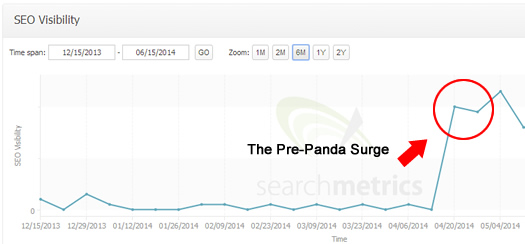
Content Strategy and Inviting Panda to Dinner
As I explained earlier, the company had seen a spike in Google organic traffic, based on a new content strategy. I began quickly reviewing their rankings, the landing pages receiving Google organic traffic, their trending over time, etc. And again, what I found was shocking.
The company’s goal was to drive prospective customers to their site, only to drive them to their mobile apps in the Google Play Store or the Apple App Store (to download the apps). That sounds fine, but the devil is the in the details.
The site had approximately 15K pages indexed and almost all of them were extremely thin, content-wise. The pages consisted of a thumbnail image, a title, and no other content. For users on desktop, the thumbnail images sometimes linked downstream to videos that the company didn’t own (and were located on a third party site). The company had licensing deals in place to play the video clips in their mobile app, but not on the website. And sometimes the thumbnail images didn’t link to anything at all (the page was a dead end). I’ll cover the mobile experience soon, which was also extremely problematic.
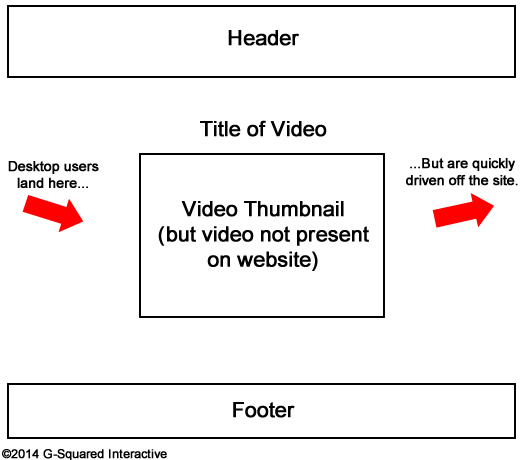
So, you had a lot of thin content, and a serious downstream problem. Engagement had to be horrible for most visitors, and the users that did choose to engage, were driven off the site quickly. If you’ve read my posts about Panda in the past, you know that poor user engagement is a giant invite to the mighty Panda. But, combining crazy thin content with poor user engagement is like breaking into the Panda’s house, drugging him, stuffing him into your SUV, dropping him on your website full of bamboo, and waking him up with a taser gun. It won’t end well, and it didn’t for this company.
It Gets Worse – Mobile Traffic
Understanding that this company’s focus was mobile, I decided to check how the site handled mobile visitors. It was hard to believe the situation could get worse, but it did. The desktop situation was sure to lead to a Panda hit (or even a manual action), but it got worse as I dug in from a mobile standpoint. After checking the mobile situation across multiple devices, I found it extremely risky on several levels.
I noticed that as soon as I clicked through to the website from the search results, the site automatically redirected me to either the Google Play Store or the Apple App Store. So I didn’t even get a chance to view anything on the site. Yes, visitors wouldn’t even land on the site, but instead, mobile traffic (including Google organic traffic) was being immediately redirected to the app stores. They were basically forcing users to download the app.
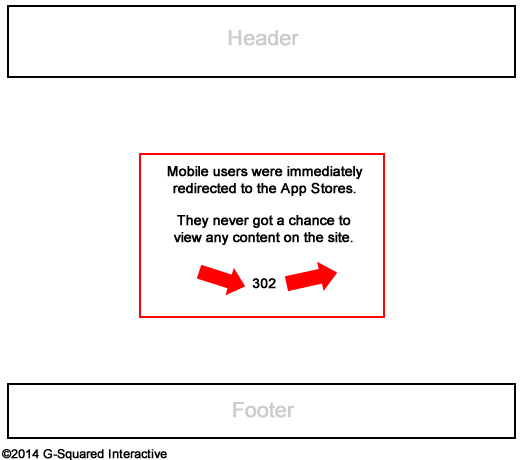
Talk about risky? They were just asking Google to punish them… On that note, I mentioned the Panda recipe of death in my last Search Engine Watch column. Well, this was a high-octane version of the cocktail. You can substitute grain alcohol for rum in this version of the drink.
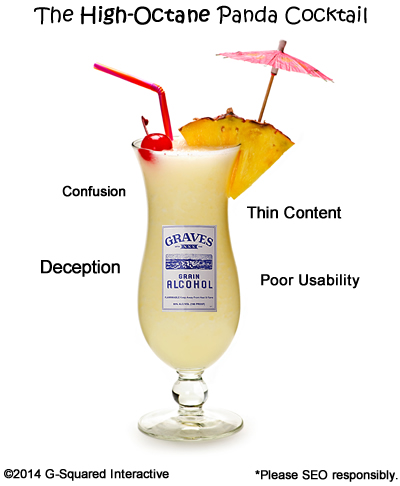
Thousands of thin pages were indexed, the pages ranking were ranking well, desktop users spent very little time on the site, and mobile traffic was immediately redirected off the site to the app stores. There was no engagement, no strong content, and no real focus from a content strategy standpoint. In addition, the site was clearly providing boatloads of content for the sole purpose of ranking in Google to attract users searching for popular terms (with the hope of getting some of them to download their apps). Like I said earlier, the site was teed up to get smoked by Panda.
A Note About Google and Smartphone Visitors
Google is already getting tough on websites in the smartphone rankings by demoting sites that implement faulty redirects. And now they will provide a message in the search results in addition to providing a demotion. Can you tell Google wants to ensure its users have a positive experience on their phones?
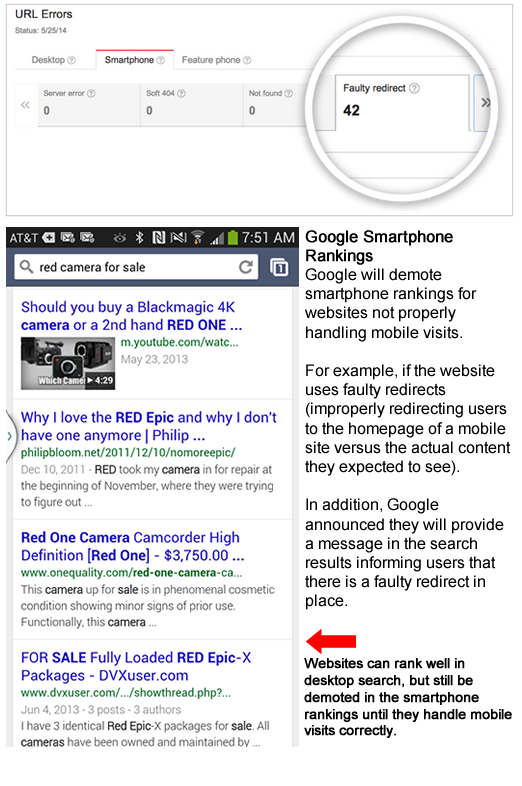
But the redirects I was seeing on this site were even worse than standard faulty redirects… These redirects take users automatically off of the site, basically forcing them to download mobile apps to view content. Not good, to say the least.
No Time To Help, But A Smart Recommendation
Back to the company needing SEO help. So, I spoke with one of the founders and explained that I didn’t have much availability at the time. But I clearly explained the problems I was seeing. I introduced Panda, I explained how Google was becoming tougher on sites from a mobile standpoint, and I explained how Google wants to protect its users from deception and poor user experience.
I basically explained that their surge in Google organic traffic was going to be short-lived. On that note, you can read my post about the sinister and misleading surge in Google organic traffic before algo updates to learn more about that phenomenon. I knew with almost 100% certainty that their site was going to get hit, and sooner than later. It was obvious to me after analyzing many sites impacted from Panda since February of 2011.
So the call ended and I told them I would get in touch if time opened in my schedule (which it hasn’t, ironically due to the very algorithm update that hit their website). Panda 4.0 rolled out on May 20, 2014, and as I’ve documented in my posts about the update, it was huge. Many websites got smoked during P4.0, and it sure looks like this company was one of the casualties.
Detailing The Panda 4.0 Hit
Checking SEMRush and SearchMetrics for the website at hand, I saw a distinct dip after Panda 4.0 rolled out. And checking both traffic and keyword trending, I could see more Panda tremors in the weeks following Panda 4.0 (which I have seen consistently across sites impacted by P4.0).
Then I started checking the various keywords the site used to rank for, and low and behold, the site was not ranking at all anymore. Actually, I couldn’t find the site ranking anywhere for those keywords (even if I added the domain name to the search!) Google had indeed smoked the site.
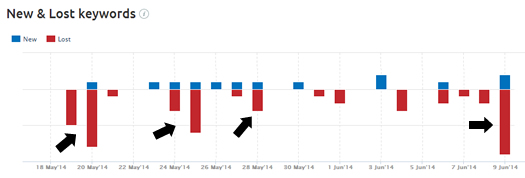
I tested this across both desktop and mobile and could not find the site ranking at all. So either Panda 4.0 took care of the situation, or they’ve been hit with a manual action. I can’t tell for sure since I don’t have access to the company’s Google Webmaster Tools account (remember, I didn’t have time to help them originally). But the site saw a big drop right around May 20 and has seen subsequent panda tremors since then. It sure looks like Panda 4.0 to me.
As of Friday, June 13, the site still had thousands of thin pages indexed, and the mobile redirects were still in place. But then Saturday, June 14 revealed a big change. All of the pages must have been taken down the day prior. The company must have seen the impact from Panda 4.0 and decided to nuke all of the thin content, the mobile redirects, etc. I wish they would have done that when I first told them to. :)
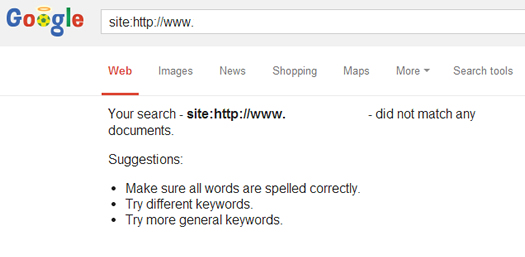
So I’m not sure what the company has planned moving forward, but it’s pretty clear that their previous content strategy took them down a very dangerous path. A path filled with SEO mines and lots of bamboo. They have their work cut out for them if they want to recover, which is a horrible place to be for a startup.
Panda Lessons – Content Strategy and SEO
The term “content strategy” gets thrown around a lot in marketing departments (especially over the past few years). But it should not be taken lightly. Great content is critically important from an SEO standpoint. It’s the reason the mighty Panda was created by Google in the first place. If you don’t have the chops to create unique, killer content, then SEO is probably not for you.
Hey, there is always AdWords, Bing Ads, and Facebook Ads if SEO isn’t your thing. Those can be viable solutions, but you’ll pay for every visitor. That doesn’t sound great, but it’s better than artificially boosting your Google organic traffic in the short-term, only to burn your domain by breaking the rules.
Here’s an important recommendation for any company looking to increase quality traffic from SEO. If you are going to craft a strong content strategy, then absolutely get an experienced SEO involved from the beginning. In today’s Google environment, it’s way too risky to go down the wrong path, test the Panda waters, only to get smoked by an algorithm update.
If you do, you’ll have months of recovery to deal with. And you would have wasted time, money, and resources on a plan that’s destined to fail. I’ve seen too many companies go down this path and then call me after it’s too late. Those calls are tough… there’s a lot of silence on the other end of the line when I explain what actually happened. Avoid situations like that at all costs.
Tips For Developing The Right Content Strategy
I wanted to end this post with some recommendations for companies that are new to SEO, but want to develop a strong content strategy. The bullets below are merely a starting point, but they are still incredibly important.
- Research is Key
Don’t rush into producing content. Complete the necessary research first. Understand your niche, your target audience, and what people are searching for. It’s a great starting point. - Competitive Analysis
Competitive intelligence is also extremely important. Fully analyze your competition, what they are ranking for, the landing pages receiving traffic, their overall content strategy, etc. You can glean important insights from what is already out there… and who you are competing with. - Brainstorming is Good
Buy a whiteboard and brainstorm often. For companies I help with content strategy, I love facilitating brainstorming sessions based on data. I’ve always said that if you get your top people in a conference room with a whiteboard and start brainstorming ideas, you’ll have a year’s worth of content mapped out. And add data from the first two bullets above and you’ll be in even better shape. - Add An Experienced SEO to the Mix
Hire an SEO to help develop and then review your content strategy. I don’t care if that’s an in-house SEO, consultant, or agency, but definitely have one involved. Professional SEOs will understand how to effectively research a niche, a target audience, and the competition. In addition, they will be up to speed on Google’s latest algorithms, manual actions, and guidelines. It’s like an insurance plan for your website. If you avoid this step, then proceed at your own peril. - Continual Analysis
Companies should continually analyze their efforts to understand the true impact of a content strategy. For example, analyze organic search traffic, referral traffic, linkbuilding, conversion, revenue, growing a social following, etc. The beautiful part about digital marketing is the speed at which you can change. If something isn’t working, and change is needed, then you can quickly turn on a dime and go down another path. Continually learn from your success and failures. That’s how you’ll succeed.
Summary – The Right Content Strategy Can Help You Avoid Panda
After reading this case study, I hope you understand the risks involved with rolling out the wrong content strategy. In the Google world we live and play in, the wrong strategy doesn’t just impact short-term organic search traffic. It can also lead to an algorithm hit or a manual action. And if that happens, you’ll have months of recovery work in front of you.
And the time, money, and resources you’ll waste on recovery work could have been used to drive more targeted traffic to the site. And by the way, there’s no guarantee you’ll recover from Panda so quickly. Like I said earlier, avoid this situation at all costs.
Start with the right content strategy, think about users, produce killer content, and avoid the mighty Panda. Good luck.
GG

Excellent article – detailed analysis. Bottom line: you can’t fake what you don’t have. Nothing replaces high quality, relevant content. Watch word placement – intent – meaning – diction. Use keywords (by all means) but not all at one time and on one page. The best practice is a keyword/phrase focus for each “page” or “post” – but keep a close eye on diction (because Google does).
Thanks Ray. I’m glad you found my post interesting. You’re spot on with the bottom line. Deception is never a good idea, and now that’s especially true since user engagement is critically important from a Panda standpoint. I could tell very quickly that this site was teed up to get hit hard by Panda (or a manual action). And it did. Not good.
My first time on your website, read the article thoroughly, whenever i couldn’t understand something that you were trying to convey, i wished that you had given an example to further explain it. A little down did I scroll, my wish was granted.
Just loved the flow of the article.
Bookmarking it for further reference
Excellent, I’m glad you found the case study helpful. It’s a great example of what not to do… Deceiving users can absolutely lead to a Panda hit. Avoid doing that at all costs.